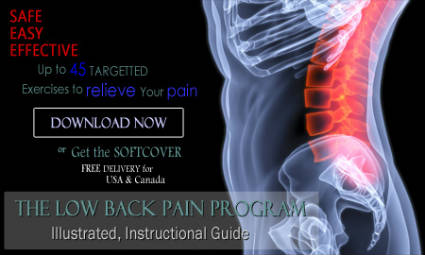Back Pain Test #5: The Full Stand Test
Test your back by standing up from the lying position

SN Health Resources | Updated Dec 14, 2020
This is the most challenging of the 5 tests (and also the most revealing)
Don’t be intimidated, you are almost there. You will find all of the effort that you have spent for these tests worth your time. Yes! there is pain relief in the long run.
If you have had any difficulty with the first 4 tests, this one may be your most difficult of all.
Here is an awesome way to self test yourself to see if you’re at risk for developing chronic back problems.
Don’t be discouraged as it is not expected to be easy to do.
This is an critical test to demonstrate your risk for back issues because it requires ALL of the muscle groups which you have been using in tests 1 through 4.
The more that you can accomplish the first 4 tests, the easier this test will become. Also, the easier that it becomes for you to perform this test, the more protection that you are providing for your lower back.
This test has a number of very important benefits for your physical health.
- Your core muscle strength
- Improving your hip flexibility
- Strengthening your knee stability
- Increasing your leg strength
- Improving your abdominal strength
- Improved hip flexor conditioning
- Releasing lower back tension
- It encourages you to actively favor using your lower body over your upper
All of these benefits work together to improve the stability of your lumbar curve and to give relief.
To begin the Full Stand Test
Caution: Balance is important for this test. Do this next to a wall for support or with a partner.
1) Begin by lying down flat on a hard surface with your legs straight.
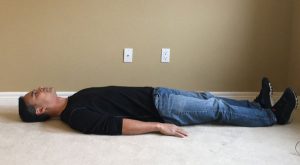
Short legs can make you top heavy. Wear shoes for balance.
2) Bend your knees slightly.
3) Place your hands on your stomach or near your hips and keep them there.
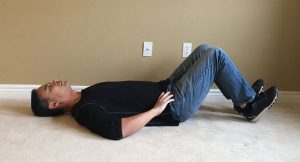
4) Slowly try to bring your upper body into a seated position while keeping your hands on your body (do not use your hands or arms to assist you).
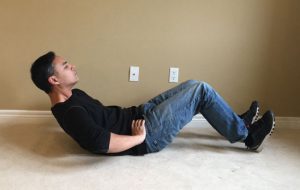
Be careful not to strain your neck. Tuck in your stomach!
5) Once you are able to sit upright, bend your knees to sit.
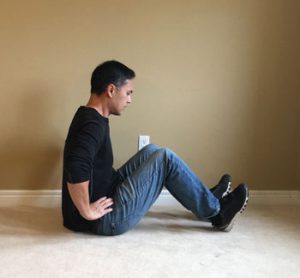
6) While sitting up, rotate your thighs sideways (one in & one out)
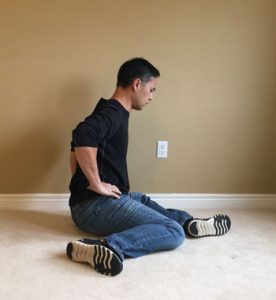
Use your hip muscles as much as you can. Lean to the side slightly.
7) Lean forward and begin to kneel

Be careful not to hurt your knees
8) Put yourself into a lunge position as shown below. Watch your knees!
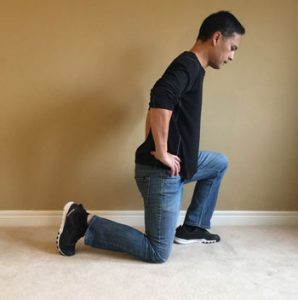
Contract your butt muscles as much as you can. Not your thighs.
9) Slowly, raise up with feet in lunge position
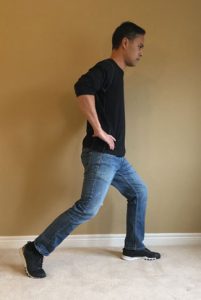
10) Relax in full stand
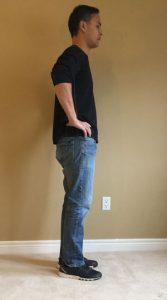
Note: Do not expect this test to be easy as you will be recruiting every protective muscle to assist you.
How Did You Do?
- How did you feel when you sat up and stood up?
- Did you have any pain/strain from any part of your body while contracting your abdominals, hip muscles or legs?
- Was is very difficult trying to elevate your upper body off of the floor?
- Was is hard for you to position your legs while entering your seated and kneeling position?
- Did you have trouble using your legs to push off of the floor?
- Was there any tension in your lower back when you rose up straight?
- Do you have an anterior pelvic tilt? If so then did it impede your ability to sit up?
If you found any difficulty with any of these questions, you are at risk of increased pain
You must work on retraining and reconditioning all of the muscle groups so that this test can become a daily or weekly activity to help KEEP you fit and not as a strenuous activity instead.
There are many exercises that you should and can do that will help you with this test.
Now that you have completed the 5 tests
Proceed to the next page to learn just how to recondition and retrain yourself to protect your spine and relieve your pain.
Next: What You Can Do Now For Help
The next page will explain where your limitations are what you need to start working on, you will benefit tremendously and your quality of life with improve greatly.
If you are in need of more help:
Go to the previous test: The Quad Test
Go to the 10 most important exercises for your lower back
Take the stretch test to find out just how ready you are to stretch
Follow The Low Back Pain Program to learn exactly how to master all 5 tests and protect you

